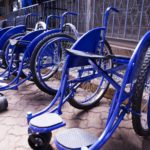Quacks, cures and curiousities

Throughout human history, various methods have been used to determine the health of an individual. Most are now classed as baseless.
Witch-doctors are said to use auto-suggestion and placebos, while more recently we have been introduced to phrenology (the study of the bumps on a person’s head); iridology (study of the patterns in the iris); chiromancy (palm-reading to determine a person’s future and health); palmistry (determining a person’s character and health).
Some people claim to be able to see a patient’s aura (tantra) colours to show overall health amongst others; the overall smell of a person (odourology?); shape and colour of the faeces (manurology?) before pharmacy testing; colour and smell of the urine – once again before lab testing.
We are now using animals (dogs and cats) to sense cancer, various biological diseases and even the presence of life (i.e. after a catastrophe). Scientists have developed an artificial intelligence (AI) tool capable of diagnosing and predicting the risk of developing multiple health conditions — from ocular diseases to heart failure to Parkinson’s disease — all on the basis of people’s retinal images. Maybe the old methods weren’t so way out after all.
In Chinese medicine, after years of diagnostic experience, Chinese medicine experts have discovered that the thenar part of human palm prints can be found to be related to asthma and other allergic diseases in terms of its lines and roughness. Traditional Chinese medicine can provide diagnostic evidence for some allergic diseases through the characteristics of palm prints in the thenar area.
However, TCM judges the condition through observation, pulse diagnosis, inquiry and research, which is subjective. If it is possible to identify and classify the collected large thenar palm print pictures through a computer, according to certain quantification rules, extract the characteristics of the yin and yang large thenar palm prints, and then classify them.
Because computer recognition has a certain degree of objectivity, it can play a certain auxiliary diagnostic role in TCM diagnosis and provide convenience for TCM diagnosis. There was a positive correlation between blood groups and palm-print patterns.
Palm reading as a form of fortune-telling is as phony as it is ancient. As an aid to medical diagnosis, it is as promising as it is new. The latest addition to the arcane art comes from the strange palm-print patterns found on babies born to mothers who had German measles early in their pregnancy during the epidemic that swept the U.S. in 1964-65. Since these are babies likely to be suffering from hidden but serious abnormalities, reports Brooklyn’s Dr. Ruth Achs, the visible but minor abnormalities of their palms may well be a valuable medical clue.
Congenital defects
The first suggestion that finger and palm prints might be associated with disease came only 30 years ago, almost half a century after Sir Francis Gallon linked them with genetics, and helped to lay the foundations of a science now called dermatoglyphics.
Dr. Harold Cummins of Tulane University noted a distinctive pattern in victims of mongolism (Down’s syndrome). Another Tulane team, led by Dr. Alfred R. Hale, showed that many patients with inborn heart defects had palm-ridge abnormalities, whereas those with heart disease or disorders acquired after birth usually had normal prints.
By the end of 1965, researchers had linked abnormal palm prints with no fewer than 19 disorders (counting many chromosomal mixups), including two more forms of mongolism, the absence of fingernails or toenails, webbing between the fingers and toes, and possibly phenylketonuria or PKU. It is evident that most diseases/conditions do follow some form of pathological patterns or symptomatic features as reflected on the palm.
Maybe we should not unilaterally neglect traditional diagnostics or remedies, but at least attempt to analyse what, if any, were the basic concepts behind their introduction and general use.
It has been known for some time that a person can be made ill by mere suggestion. In the same way, one can be cured either by suggestion or by the use of a placebo. The human brain is ably to control the body in ways that have yet to be discovered. We only use a small percentage of our brains in ways that can be detected, so a lot of what goes on in our skulls remains a mystery.
We can sense a person in a dark room or when we are being followed with intent or being stared at for prolonged periods. Telepathy has been shown to be possible in a mind/machine context. We still have a long way to go in the analysis of our minds. Researchers have just spent ten years in a massive project the study of our brains and it seems we have barely touched the surface.
If we can learn to control our thoughts and imaginations, then maybe we could indeed move mountains.

Alan Stevenson spent four years in the Royal Australian Navy; four years at a seminary in Brisbane and the rest of his life in computers as an operator, programmer and systems analyst. His interests include popular science, travel, philosophy and writing for Open Forum.













